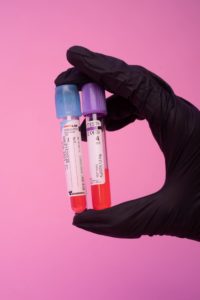Bay Biosciences provides high quality, clinical grade samples with matched frozen sera (serum), K2-EDTA plasma and nasopharyngeal swab samples from unique parainfluenza patients.
The sera (serum), K2-EDTA plasma and PBMCs are processed from metabolic disease patient’s peripheral whole-blood using customized collection and processing protocols.

Nasopharyngeal Swab Samples Overview
A nasopharyngeal swab, one type of nasal swab, is a test used to look for bacteria or viruses that cause respiratory infections. Your healthcare provider uses a swab to take a small sample of cells from your nasopharynx, the top part of your nose and throat. The long, thin part of the swab is made of flexible plastic or wire. There’s a tip on the end of the swab that absorbs a sample of fluid from your nasopharynx.
What is Parainfluenza?
Parainfluenza refers to a group of viruses called human parainfluenza viruses (HPIVs). There are four viruses in this group. Moreover, each one causes different symptoms and illnesses.
Although, all forms of HPIV cause an infection in either the upper or lower respiratory area of a person’s body. However, respiratory illnesses cause mild to serious symptoms, like sore throat, cough and shortness of breath.
In fact, symptoms of HPIVs are often similar to those of the common cold. When cases are mild, the viruses may be misdiagnosed.
Most people who contract HPIV recover with no treatment. However, someone with a weakened immune system has a higher risk of developing a life threatening infection or complications.
Types of Parainfluenza Viruses
Four types of HPIV exist. They all cause a respiratory infection, but the type of infection, symptoms, and location of the infection depends on the type of virus you have.
Following are the four types of HPIV:
HPIV-1
HPIV-1 is a common cause of croup in children. Croup is a respiratory illness that appears as swelling near the vocal cords and in other parts of the upper respiratory system.
Human parainfluenza virus (HPIV-1) is generally responsible for outbreaks of croup in the fall. In the United States, the outbreaks tend to be more widespread in odd-numbered years.
HPIV-2
HPIV-2 causes croup in children, but doctors detect it much less often than HPIV-1. It’s seen mostly in the fall months but to a lesser degree than HPIV-1.
HPIV-3
HPIV-3 is mostly associated with pneumonia and bronchiolitis, which is swelling from inflammation in the smallest airways in the lungs. It often causes infections in the spring and early summer, but it appears throughout the year.
However, with HPIV-3, the exact period of time you’re contagious hasn’t been determined. However, it has been shown that viral shedding — and therefore the risk of passing on HPIV-3 — may occur for several months even if you no longer have symptoms.
HPIV-4
HPIV-4 is rarer than the other parainfluenza types. Unlike the other strains of HPIV, there are no known seasonal patterns of HPIV-4.
How is Parainfluenza Transmitted?
You may contract HPIV in several ways.
HPIV can survive on a porous surface for up to 10 hours. Therefore, if you touch a contaminated surface with your hands and then touch your nose or mouth, you may contract the virus.
Also, the viruses can also be transmitted by having close contact with someone who has HPIV. Moreover, contact includes touching them or being in an area (especially indoors) where they have been coughing or sneezing.
It usually takes between 2 and 7 days after transmission for symptoms to appear. Even if you’ve had HPIV before, it’s possible to contract it again.
Symptoms of Parainfluenza
HPIV-1 and HPIV-2 generally cause croup and symptoms similar to the common cold, while HPIV-3 and HPIV-4 often cause pneumonia and bronchiolitis.
Symptoms may include:
- Cough
- Fever
- Ear Pain
- stuffy nose
- Sore throat
- Shortness of breath
- Stuffy nose
- Wheezing
Most often, the symptoms of HPIVs are not severe enough to cause concern in healthy adults. But they can be life threatening in an infant, older adult, or anyone with a compromised or weakened immune system.
If you’re considered part of the high risk group and you develop HPIV symptoms, reach out to a doctor right away or go to an emergency room if symptoms worsen.
Diagnosis of Parainfluenza
Your doctor may do a physical exam to determine if your symptoms match those of HPIVs.
For a more accurate diagnosis, a healthcare professional may take a throat or nasal swab. These can detect and identify the presence of a virus in cell cultures. Your doctor can also use them to detect antigens your body made to fight the virus.
Your doctor may order imaging tests, such as a chest X-ray or CT scan of your chest, to see what’s happening in your respiratory system. X-rays and CT scans can help your doctor determine the extent of your symptoms and whether you have complications such as pneumonia.
Biospecimens
Bay Biosciences is a global leader in providing researchers with high quality, clinical grade, fully characterized human tissue samples, bio-specimens, and human bio-fluid collections.
Samples available include cancer (tumor) tissue, cancer serum, cancer plasma, cancer, peripheral blood mononuclear cells (PBMC). and human tissue samples from most other therapeutic areas and diseases.
Bay Biosciences maintains and manages its own bio-repository, the human tissue bank (biobank) consisting of thousands of diseased samples (specimens) and from normal healthy donors available in all formats and types.
In fact, our biobank procures and stores fully consented, de-identified and institutional review boards (IRB) approved human tissue samples and matched controls.
Our human tissue collections, specimens, and bio-fluids come with detailed patient clinical data associated with them.
So this critical patient’s clinical data includes information relating to their past and current disease, treatment history, lifestyle choices, biomarkers, and genetic information.
Additionally, new effective treatments (drug discovery & development) in oncology, and other therapeutic areas and diseases are identified by researchers using patient’s data which is extremely valuable.
Bay Biosciences banks wide variety of human tissue samples and biological samples, including cryogenically preserved at – 80°C.
For example fresh frozen tissue samples, tumor tissue samples, formalin-fixed paraffin-embedded (FFPE), tissue slides, with matching human bio-fluids, whole blood and blood-derived products such as serum, plasma and PBMC.
Bay Biosciences is a global leader in collecting and providing human tissue samples according to the specified requirements and customized, tailor-made collection protocols.
Please contact us anytime to discuss your special research projects and customized human tissue sample requirements.
Types of Biospecimens
Bay Biosciences provides human tissue samples (human specimens) from diseased and normal healthy donors which includes:
- Peripheral whole-blood
- Amniotic fluid
- Bronchoalveolar lavage fluid (BAL)
- Sputum
- Pleural effusion
- Cerebrospinal fluid (CSF)
- Serum (sera)
- Plasma
- Peripheral blood mononuclear cells (PBMC)
- Saliva
- Buffy coat
- Urine
- Stool samples
- Aqueous humor
- Vitreous humor
- Kidney stones (renal calculi)
- Other bodily fluids from most diseases including cancer.
Moreover, we can also procure most human bio-specimens, special collections and requests for human samples that are difficult to find. All our human tissue samples are procured through IRB-approved clinical protocols and procedures.
In addition to the standard processing protocols, Bay Biosciences can also provide human plasma, serum, and PBMC bio-fluid samples using custom processing protocols; you buy donor-specific collections in higher volumes and specified sample aliquots from us.
Bay Biosciences also provides human samples from normal healthy donors; volunteers, for controls and clinical research, contact us Now.
日本のお客様は、ベイバイオサイエンスジャパンBay Biosciences Japanまたはhttp://baybiosciences-jp.com/contact/までご連絡ください。

